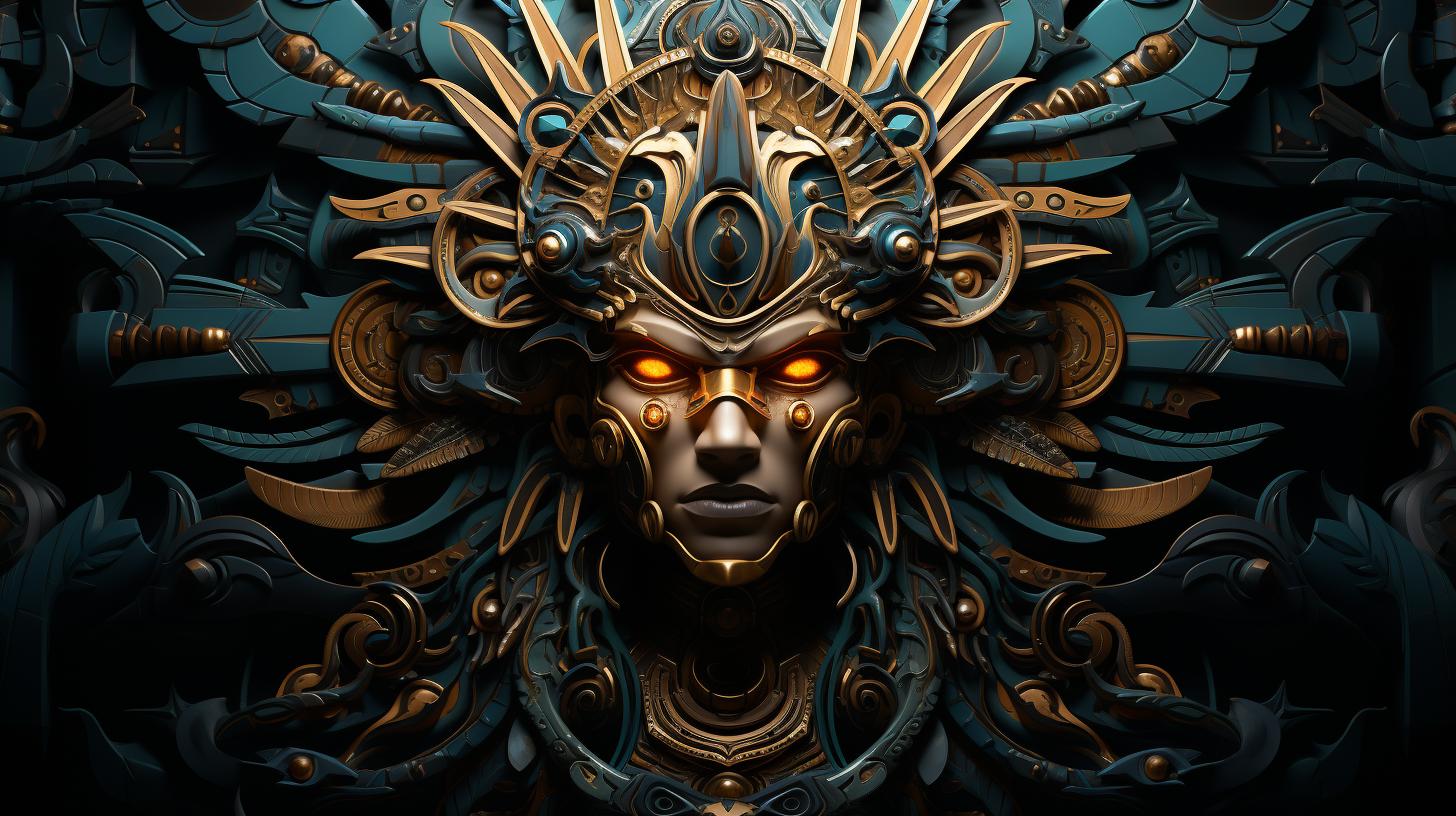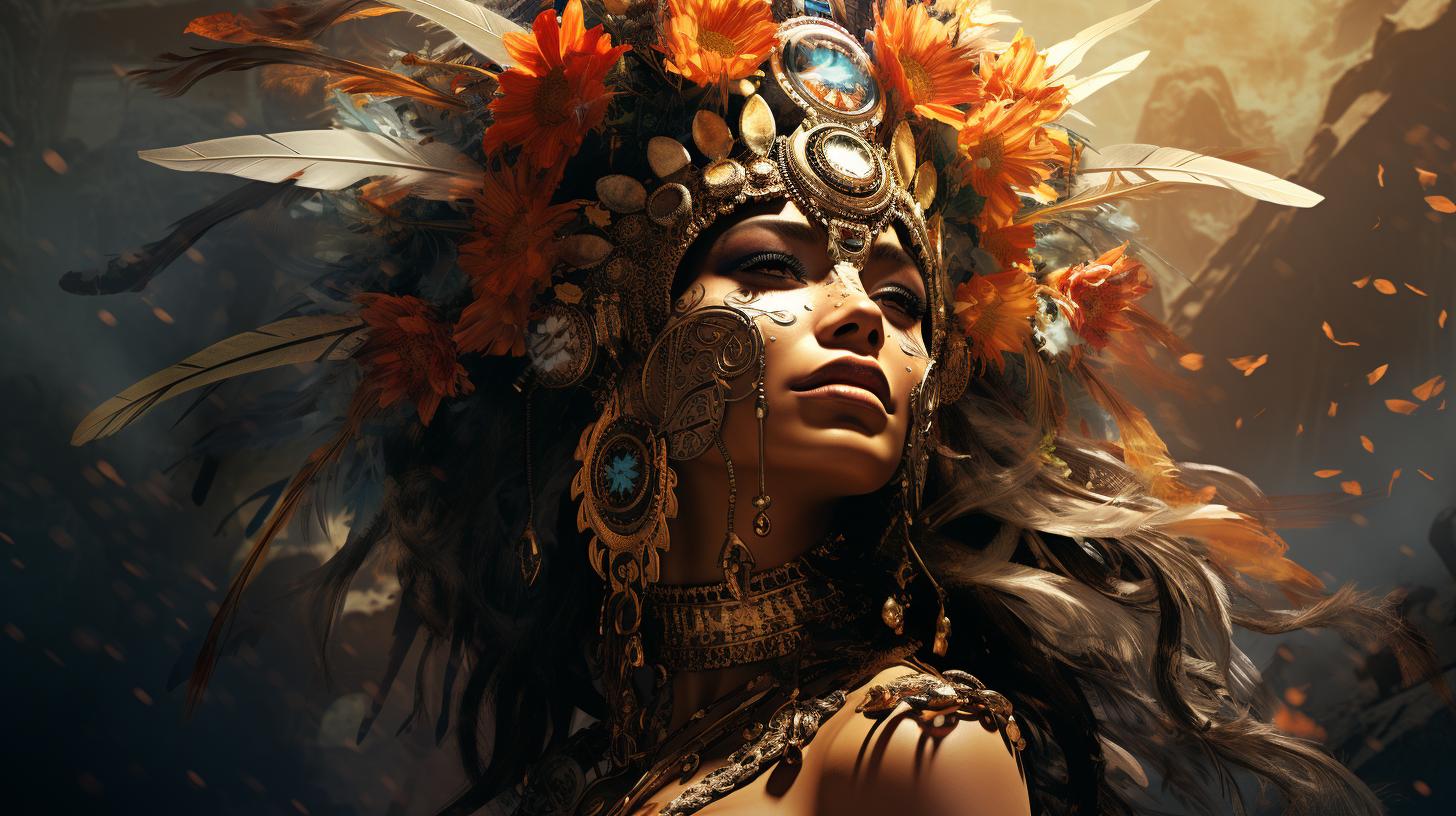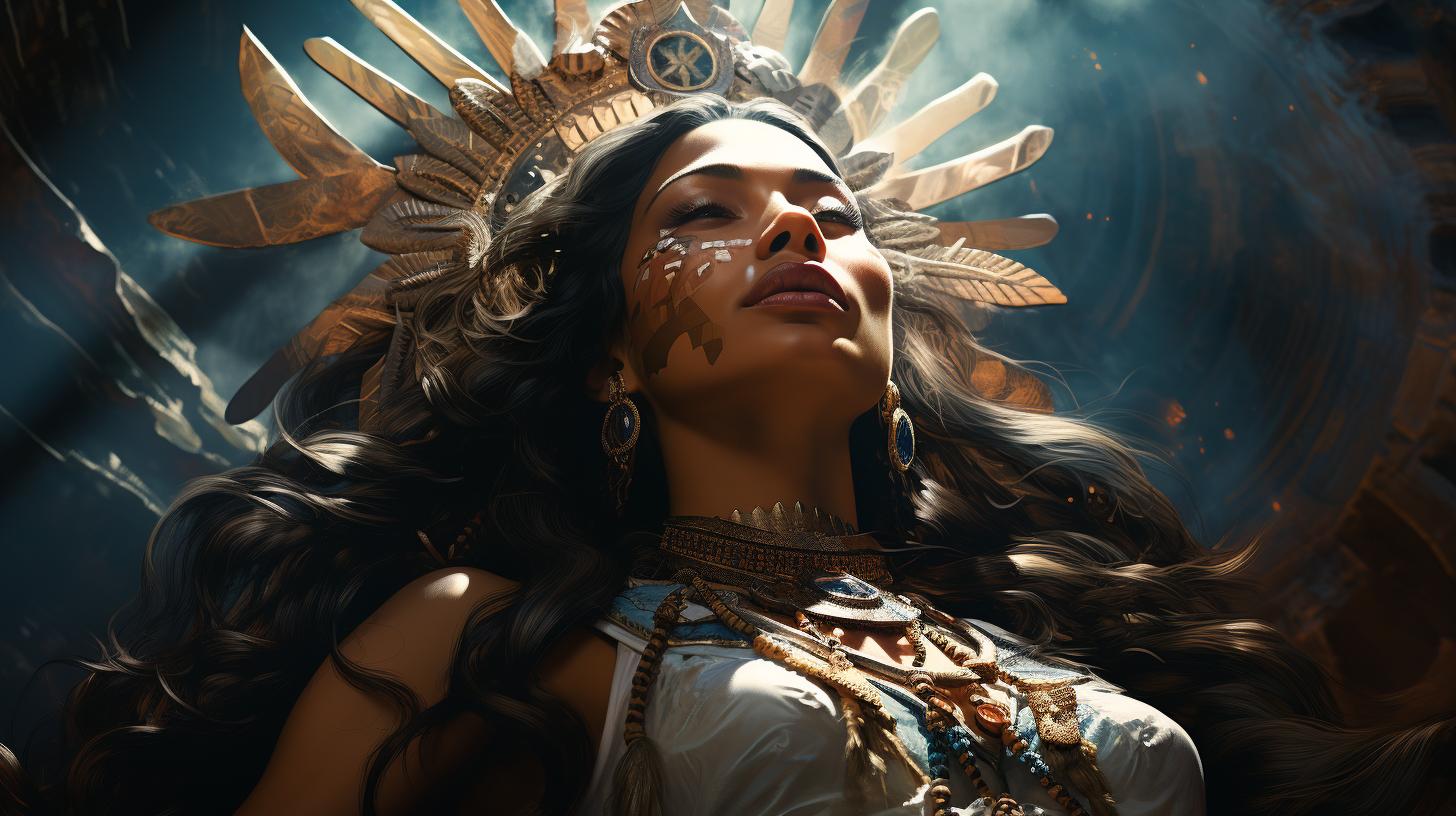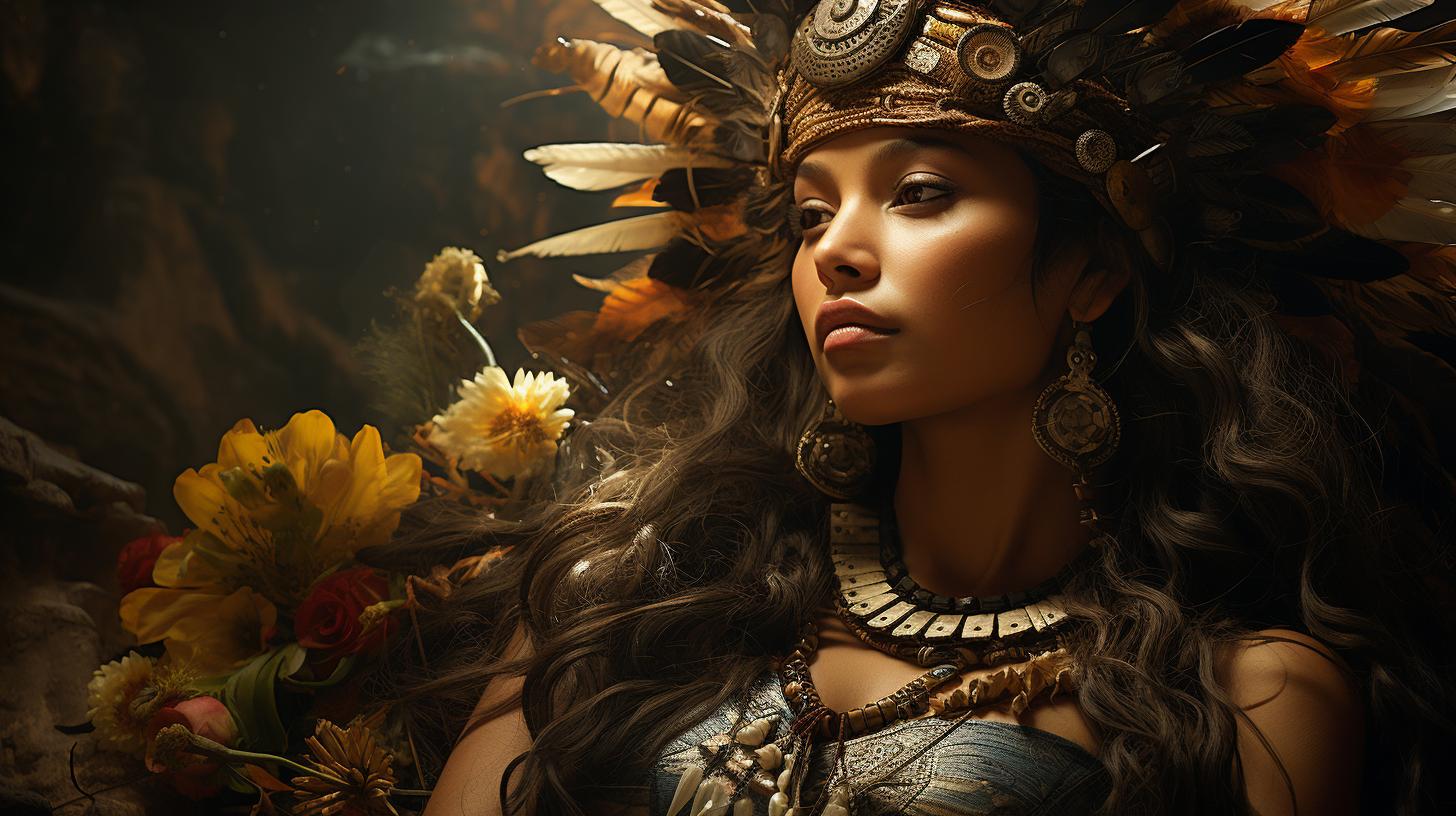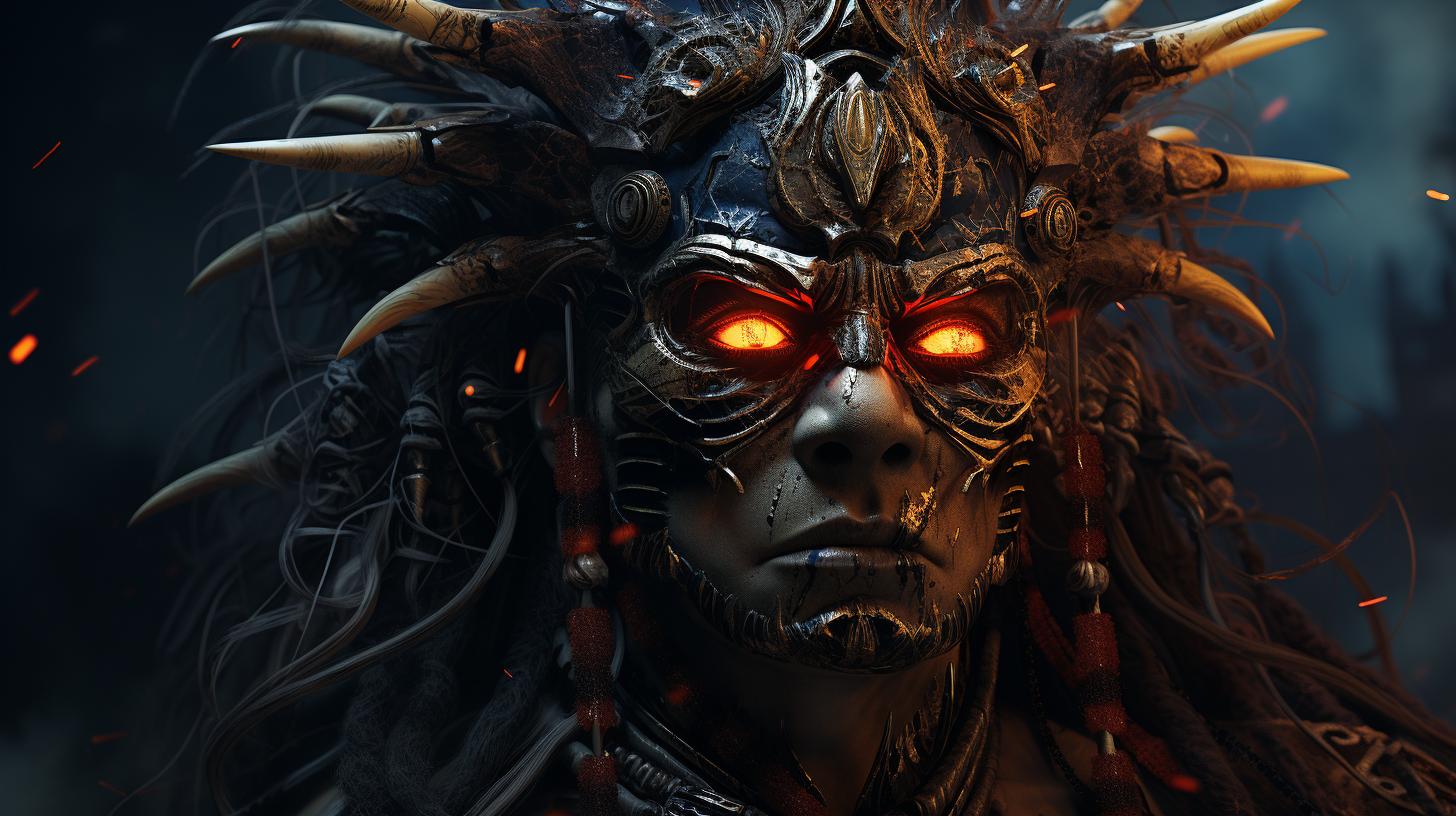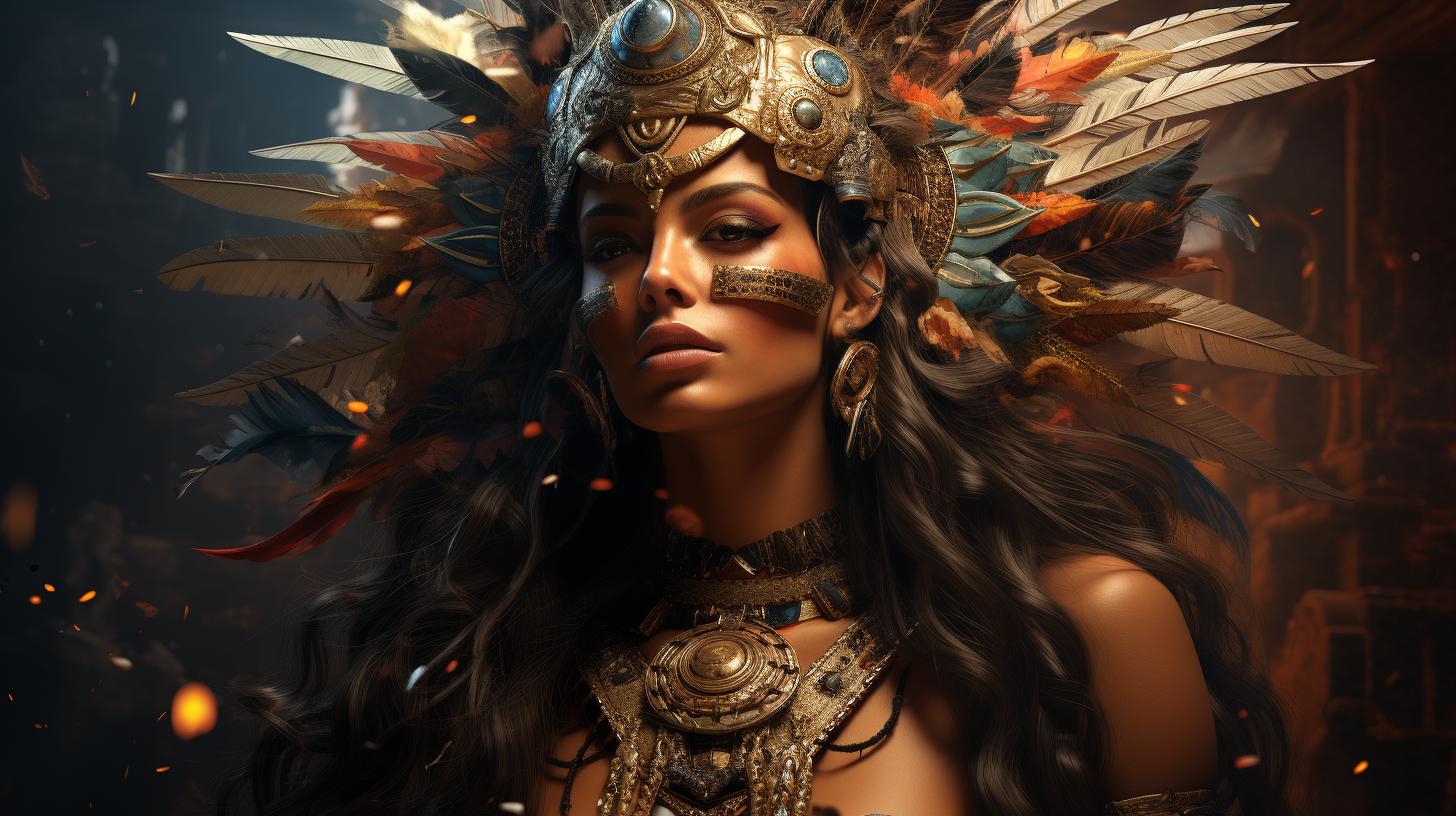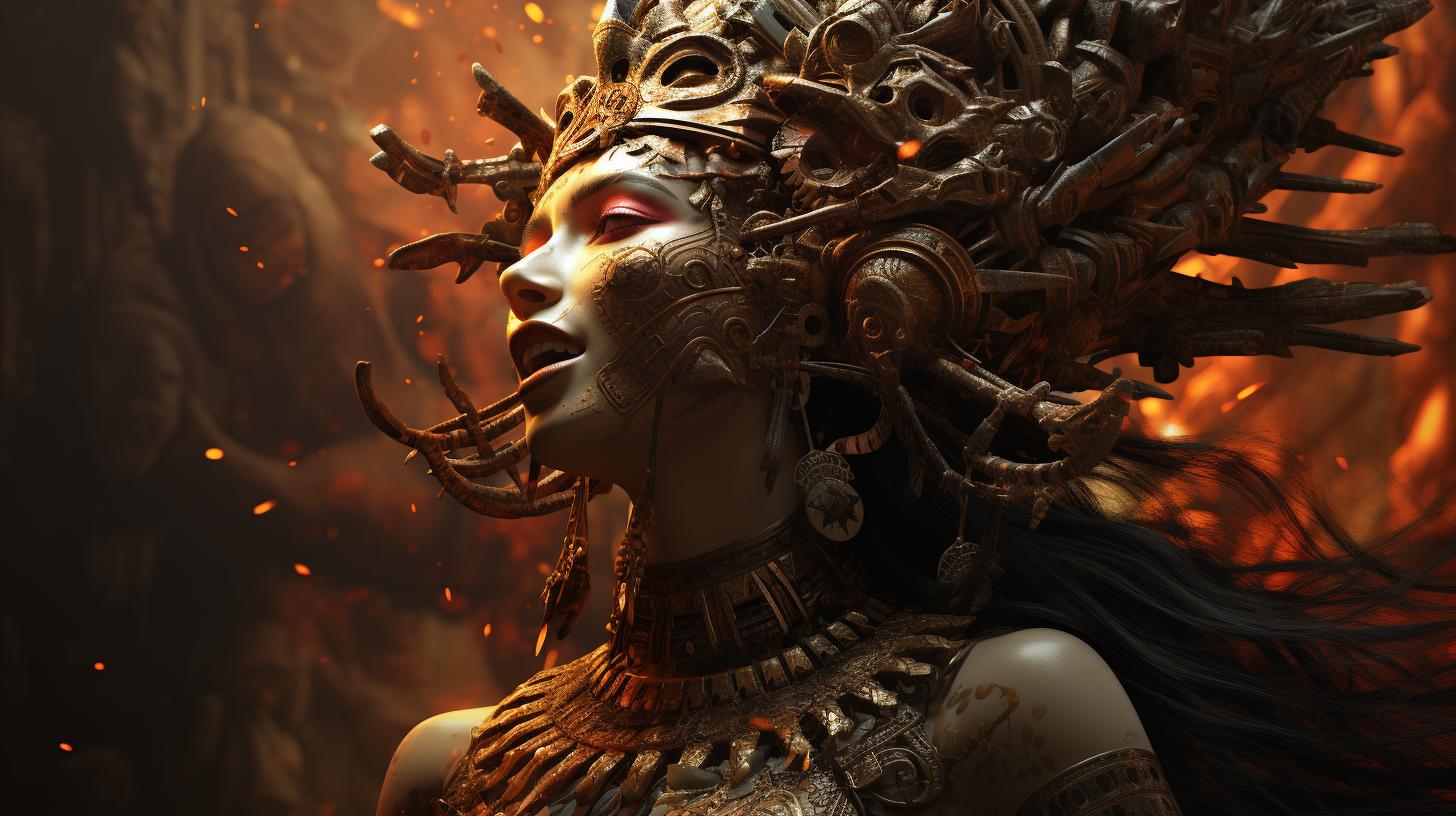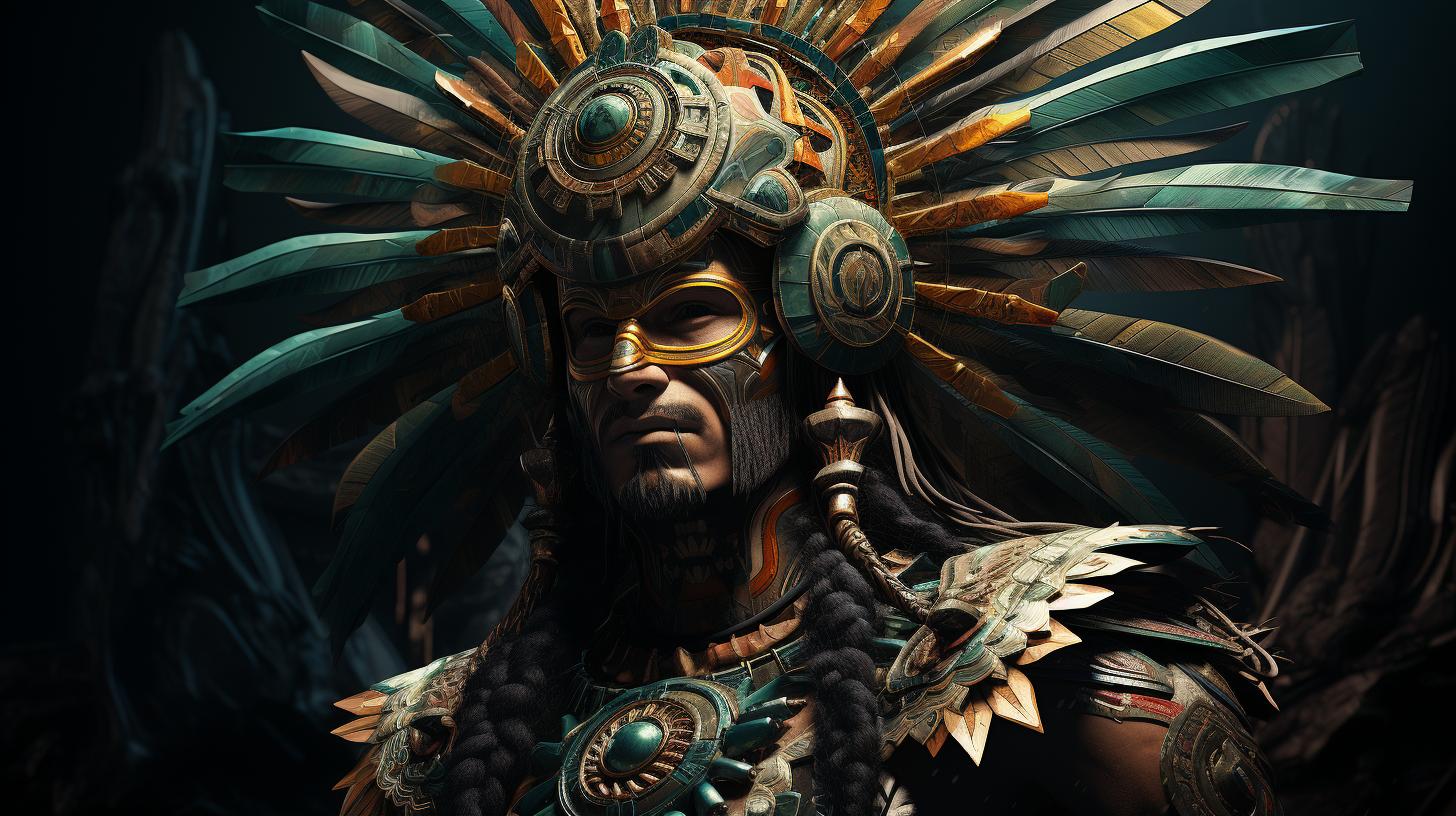Tlahuizcalpantecuhtli: The Fascinating Aztec God of Venus
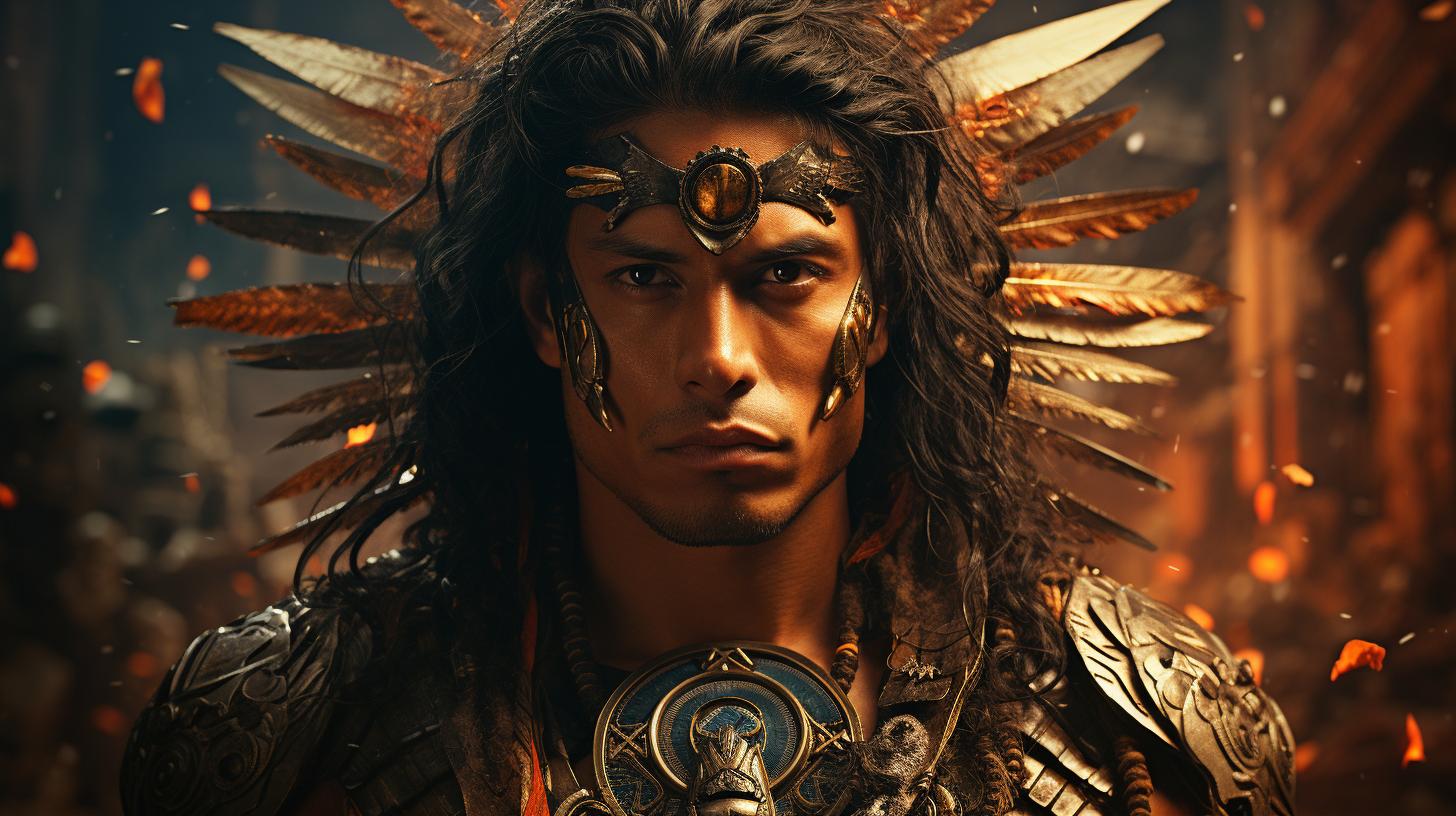
Tlahuizcalpantecuhtli is a significant deity in Aztec mythology and Mesoamerican culture, associated with the planet Venus as the Morning Star. With a name meaning ‘Lord of the House of Dawn’, Tlahuizcalpantecuhtli holds a dual role as the Morning Star (Quetzalcoatl) and the Evening Star (Xolotl). This god’s connection to Venus was highly regarded by ancient Mesoamericans, who closely observed its 584-day cycle and believed in the power of its rays.
Tlahuizcalpantecuhtli is depicted in art with a feathered crown and star-shaped markings, representing his role as both a war deity and a celestial figure.
The Origins of Tlahuizcalpantecuhtli in Aztec Mythology
Tlahuizcalpantecuhtli is a revered figure in Aztec mythology, deeply rooted in the rich tapestry of ancient Mesoamerican beliefs and cosmology.
His origins can be traced back to the Aztec pantheon, where he held a prominent and distinctive role as the god associated with the Morning Star, Venus.
In Aztec cosmology, the celestial bodies were regarded as divine entities, and the movement of the stars and planets held great significance.
Tlahuizcalpantecuhtli, with his connection to the Morning Star, was believed to herald the dawn, guiding the transition from darkness to light. As the first rays of sunlight broke through the darkness, it was believed that Tlahuizcalpantecuhtli’s presence marked the beginning of a new day.
The ancient Aztecs attributed various symbolic meanings to Tlahuizcalpantecuhtli, perceiving him as a powerful force that influenced the cycles of life and death. His association with the Morning Star bestowed upon him a sense of rebirth and renewal, representing the eternal rhythm of the cosmos.
According to Aztec mythology, Tlahuizcalpantecuhtli was not only the god of the Morning Star but also held the dual aspect of the Evening Star. In his guise as the Evening Star, he took on the name Xolotl, a deity associated with twilight, sunset, and the underworld.
This duality of Tlahuizcalpantecuhtli’s nature reflected the concept of balance and harmony within the Aztec worldview.
The worship and reverence of Tlahuizcalpantecuhtli can be traced back to the ancient Aztec civilization, where his presence and influence permeated every aspect of life.
He was venerated through rituals, ceremonies, and prayers, showcasing the deep spiritual connection the Aztecs had with the celestial realm.
It is through exploring the origins of Tlahuizcalpantecuhtli that we can begin to understand the deep-rooted significance of this Aztec god in their mythology and cultural beliefs.
From his role as the herald of the dawn to his symbolically dual nature as both the Morning and Evening Star, Tlahuizcalpantecuhtli embodies the complex and intricate cosmology of the Aztec people.
The Role of Tlahuizcalpantecuhtli as the Morning Star
In Aztec mythology, Tlahuizcalpantecuhtli plays a significant role as the Morning Star, representing the celestial entity known as Quetzalcoatl. As the Morning Star, Tlahuizcalpantecuhtli symbolizes the beginning of a new day, the emergence of light, and the transition from darkness to sunlight.
According to Aztec beliefs, Tlahuizcalpantecuhtli’s appearance as the Morning Star carried profound significance. His presence in the sky marked the start of a new cycle, representing hope, renewal, and the opportunity to embark on new endeavors.
It was believed that Tlahuizcalpantecuhtli’s radiance and influence brought blessings and favorable outcomes to those who honored him.
In addition to his role as the Morning Star, Tlahuizcalpantecuhtli also played a vital role as a warrior deity.
He was associated with conflicts, battles, and bravery. The Aztecs believed that Tlahuizcalpantecuhtli’s power as the Morning Star granted him the ability to protect and guide warriors in their military campaigns.
Furthermore, Tlahuizcalpantecuhtli’s position as the Morning Star also connected him to the concept of duality. He represented the balance between light and darkness, good and evil, and the cyclical nature of existence.
As the Morning Star, Tlahuizcalpantecuhtli embodied the transformative power of celestial bodies and their influence on the world.
The Aztecs closely observed the movements of Tlahuizcalpantecuhtli as the Morning Star, recognizing the patterns and cycles in which he appeared and disappeared.
They believed that these celestial events held profound wisdom and knowledge, serving as divine messages or omens for important events in human life.
To honor Tlahuizcalpantecuhtli as the Morning Star, the Aztecs carried out rituals, ceremonies, and offerings.
They sought his favor and guidance, believing that by aligning themselves with the celestial forces embodied by Tlahuizcalpantecuhtli, they could achieve prosperity, success, and spiritual enlightenment.
Tlahuizcalpantecuhtli as the Evening Star: Quetzalcoatl and Xolotl
Tlahuizcalpantecuhtli, the Aztec god associated with Venus, played a fascinating role as both the Morning Star and the Evening Star.
In Aztec mythology, the Evening Star was represented by Quetzalcoatl, the Feathered Serpent deity, while Xolotl, the god of monsters and deformities, represented the Morning Star.
The Evening Star, embodied by Quetzalcoatl, symbolized the descent of Tlahuizcalpantecuhtli into the underworld after sunset.
This celestial journey was believed to represent Quetzalcoatl’s role as the bringer of wisdom, enlightenment, and fertility. As the Evening Star, Tlahuizcalpantecuhtli was revered for guiding souls through the dangerous realms of the dead, ensuring their safe passage.
On the other hand, Xolotl personified the Morning Star, representing the rebirth and resurrection of Tlahuizcalpantecuhtli at dawn. Seen as a shapeshifter, Xolotl was often depicted in a monstrous, dog-like form.
His association with the Morning Star conveyed the idea of a new beginning, the start of a new day, and the renewal of life.
The duality of Tlahuizcalpantecuhtli as both the Evening Star and the Morning Star reflects the Aztecs’ understanding of the cyclical nature of life, death, and the cosmos.
This concept represented a constant balance between light and darkness, day and night, birth and death.
The Connection Between Tlahuizcalpantecuhtli and Venus
Tlahuizcalpantecuhtli, the Aztec god associated with Venus, has a significant connection to this celestial body in Mesoamerican cosmology. The ancient Mesoamericans, known for their expertise in astronomy, closely observed the cycle of Venus, an astronomical phenomenon that spans 584 days.
Considered the third brightest object in the sky after the sun and the moon, Venus held immense importance in their celestial observations. The appearance and disappearance of Venus were precise and predictable to these ancient astronomers, allowing them to accurately forecast cosmic events.
The rays of Venus at dawn were believed to possess immense power and were considered lethal. These morning rays, often referred to as the “morning star,” were associated with Tlahuizcalpantecuhtli.
It was believed that his presence was embodied in these radiant rays, making him a powerful and revered figure within the Aztec pantheon.
In Aztec art and architecture, representations of Tlahuizcalpantecuhtli can be found, adorned with a distinctive feathered crown resembling a sharp beak.
Additionally, the depictions often showcase white star-shaped markings on the forehead, cheeks, nose, and chin, symbolizing the association with the celestial realm.
The Aztecs portrayed Tlahuizcalpantecuhtli carrying symbols of warfare, such as spears and shields, emphasizing his role as a god of war.
These depictions can be found in cave paintings and ancient codices, providing insights into the cultural significance of Tlahuizcalpantecuhtli as a multidimensional deity.
The connection between Tlahuizcalpantecuhtli and Venus extends beyond his association with the morning star.
He also embodies the concept of the Evening Star, represented by Quetzalcoatl and Xolotl. This duality showcases the complexity of his character and highlights his presence in both the dawn and dusk skies.
The intricate relationship between Tlahuizcalpantecuhtli and Venus reveals the depth of Aztec cosmology and their profound understanding of celestial bodies. Their observations and interpretations served as a foundation for their spiritual beliefs and rituals, emphasizing the intricate connection between the earthly and celestial realms.
Tlahuizcalpantecuhtli in Mesoamerican Astronomy and Cosmology
The figure of Tlahuizcalpantecuhtli holds a significant place in Mesoamerican astronomy and cosmology. The ancient peoples of Mesoamerica, known for their expertise in astronomy, closely observed the movements of celestial bodies, including the planet Venus. Tlahuizcalpantecuhtli’s association with Venus as the Morning Star and the Evening Star played a crucial role in their understanding of the cosmos.
Understanding the cycle of Venus was of utmost importance to the Mesoamericans. They were able to accurately predict its appearances and disappearances in the sky due to its 584-day cycle.
Venus was considered the third brightest celestial body after the sun and the moon, and its rays were believed to carry immense power. The appearance of Venus before sunrise was seen as a potent and even mortal event.
The Mesoamericans depicted Tlahuizcalpantecuhtli in their art and architecture, incorporating his connection with Venus in these representations. In their artistic works, Tlahuizcalpantecuhtli is often portrayed with a feathered crown resembling a sharp beak and adorned with white star-shaped markings on his forehead, cheeks, nose, and chin.
These markings symbolize the stars and further emphasize his association with Venus.
Furthermore, Tlahuizcalpantecuhtli is depicted carrying symbols of war, such as spears and shields. This representation signifies his dual role as not only a celestial deity but also a god of war.
These artistic depictions can be found in rock paintings and codices, providing insights into how the Mesoamericans perceived Tlahuizcalpantecuhtli’s celestial and warlike attributes.
In Mesoamerican cosmology, Tlahuizcalpantecuhtli’s connection with Venus was intricately linked to the understanding of the celestial cycles and the cosmological order.
The Mesoamericans believed that the movements of the stars and planets were significant in shaping their lives and events on Earth. Tlahuizcalpantecuhtli’s association with Venus served as a celestial guide and an important element in their calendar systems and rituals.
The importance of Tlahuizcalpantecuhtli in Mesoamerican astronomy and cosmology cannot be overstated. His association with Venus as the Morning Star and the Evening Star mirrored their complex understanding of celestial bodies and their influence on human life.
The depictions of Tlahuizcalpantecuhtli in art and his role in ritual practices reveal the deep spiritual connection the Mesoamericans had with the cosmos and the celestial forces represented through this deity.
The Symbolism of Tlahuizcalpantecuhtli in Art and Architecture
In Mesoamerican art and architecture, Tlahuizcalpantecuhtli is depicted with rich symbolism that reflects his celestial and war-related attributes. These representations provide valuable insights into the ancient Aztec beliefs and worldview.
One prominent symbol associated with Tlahuizcalpantecuhtli is his feathered crown in the shape of a sharp beak.
This crown signifies his connection to the celestial realm, resembling the beak of an avian creature. It symbolizes the divine power and authority associated with the deity. The intricate featherwork showcases the artisans’ craftsmanship and demonstrates the high reverence for Tlahuizcalpantecuhtli.
Another notable symbol found in depictions of Tlahuizcalpantecuhtli is the presence of white star-shaped markings on his forehead, cheeks, nose, and chin. These represent the stars and highlight his connection to the celestial bodies.
They symbolize the god’s radiance and the transformative power he possesses as the Morning and Evening Star. These star motifs also signify the cosmic balance maintained by Tlahuizcalpantecuhtli, linking him with the passage of time, seasons, and the celestial cycles.
The representations of Tlahuizcalpantecuhtli in art often include symbols of warfare, such as spears and shields. These elements emphasize his role as a god of war and illustrate his association with battles, conflict, and sacrifice.
The inclusion of these symbols reinforces the belief in Tlahuizcalpantecuhtli’s protective and martial abilities, as well as his significance in Aztec military and ritual contexts.
The artwork and architectural designs incorporating Tlahuizcalpantecuhtli are found in various forms, including murals, sculptures, and ornamental motifs.
They can be observed in temples, palaces, and public spaces throughout the Aztec empire. These depictions serve to honor and venerate Tlahuizcalpantecuhtli, providing a visual representation of his multifaceted role as a celestial entity and a god of war.
Through the symbolism depicted in art and architecture, Tlahuizcalpantecuhtli’s importance and significance in Aztec society are visually communicated. The intricate details, such as the feathered crown and the star-shaped markings, emphasize his celestial connection, while the presence of war-related symbols highlights his role as a protector and warrior deity.
These artistic representations are a testament to the deep cultural and religious beliefs surrounding Tlahuizcalpantecuhtli, shedding light on the complex worldview of the Aztec civilization.
Tlahuizcalpantecuhtli’s Role in Aztec Creation Mythology
In Aztec creation mythology, Tlahuizcalpantecuhtli plays a significant role in the story of the creation of the sun and the moon.
According to the myth, multiple gods offered themselves as sacrifices to become the new sun. Two of these gods were Nanahuatzin and Tecuciztecatl. They climbed on top of a pyre and set themselves on fire, aspiring to become the sun.
However, Nanahuatzin, being a humble deity, didn’t have the strength to fully transform into the sun. This caused worry among the other gods, but one of them, Tlahuizcalpantecuhtli, came to the rescue.
He shot an arrow at Nanahuatzin, piercing his chest and helping him fully transform into the sun.
This act of sacrifice and assistance by Tlahuizcalpantecuhtli highlights his importance in the Aztec creation myth.
He played a vital role in facilitating the birth of the sun, ensuring the continued existence of the world.
- Tlahuizcalpantecuhtli’s participation in the creation myth showcases his connection to the celestial realm.
He enabled the sun, a fundamental aspect of life, to come into being.
- His intervention demonstrated his selfless nature and willingness to help others, even at the cost of his own well-being.
- Tlahuizcalpantecuhtli’s actions also emphasize the interconnectedness of Aztec deities and their roles in maintaining the cosmic order.
- Through his involvement in the myth, Tlahuizcalpantecuhtli solidified his status as an important figure in Aztec cosmology and mythology.
The story of Tlahuizcalpantecuhtli’s role in Aztec creation mythology sheds light on his significance within the complex belief system of the Aztecs.
It underscores his connection to the celestial bodies and his contribution to the ongoing preservation of the world.
Tlahuizcalpantecuhtli: God of War and Sacrifice
In Aztec mythology, Tlahuizcalpantecuhtli played a significant role as the god of war and sacrifice. He was revered for his fierce and powerful nature, embodying the energy and strength required in battle.
Tlahuizcalpantecuhtli was associated with bravery, strategy, and victory, making him a central figure in Aztec military practices and rituals.
The Aztecs believed that war was an essential part of their existence and a way to prove their strength and honor.
Tlahuizcalpantecuhtli symbolized the relentless pursuit of conquest and the willingness to make sacrifices for the greater good of society.
As the god of sacrifice, Tlahuizcalpantecuhtli occupied a crucial role in religious ceremonies.
Human sacrifices were offered to appease the gods and ensure the continuation of the world. Tlahuizcalpantecuhtli’s influence extended beyond the battlefield, with his power invoked to provide protection, success, and blessings.
- Warrior Symbolism: Tlahuizcalpantecuhtli is often depicted in Aztec art and sculptures carrying weapons like spears and shields. These symbols of warfare emphasized his association with combat and his role as a divine warrior.
- Ritual Sacrifices: Tlahuizcalpantecuhtli was central to sacrificial rituals, with his offerings typically consisting of captured enemies or members of the Aztec community.
The sacrifices were performed to honor the gods and maintain cosmic order.
- Ceremonial Practices: Priests and warriors would invoke Tlahuizcalpantecuhtli’s guidance and favor before going into battle, seeking his protection and assistance in securing victory.
Ceremonies and rituals dedicated to this god were an integral part of Aztec military preparations.
The worship of Tlahuizcalpantecuhtli demonstrated the Aztecs’ deep spiritual connection between warfare, sacrifice, and their larger cosmological beliefs.
By honoring and appeasing this powerful god, they believed they could maintain divine favor and ensure their continued success.
Tlahuizcalpantecuhtli in Aztec Society and Beliefs
In Aztec society, Tlahuizcalpantecuhtli held a significant role as a god revered for his association with Venus and his representation of the Morning and Evening stars. The Aztecs believed that his presence and influence in the celestial realm had a direct impact on various aspects of their lives.
One of the key beliefs surrounding Tlahuizcalpantecuhtli was his connection to the concept of duality. As the ruler of the House of the Dawn, he symbolized the beginning of a new day and the hope it brought.
Conversely, as the Lord of the Evening, he represented the closing of the day and the transition into the night. This dual nature was seen as emblematic of the cycles of life and the balance between light and darkness.
The Aztecs viewed Tlahuizcalpantecuhtli as a powerful deity who played a vital role in their religious rituals and ceremonies. Priests and worshippers would pay homage to him through offerings and prayers, seeking his guidance and blessings.
He was believed to have the ability to bestow prosperity, success, and protection upon those who honored him faithfully.
In addition to his celestial significance, Tlahuizcalpantecuhtli also played a role in shaping Aztec social structures.
As the god of war, he was seen as a guardian of warriors and an embodiment of their bravery and ferocity in battle. His image adorned the shields and banners of Aztec warriors, serving as a symbol of strength and inspiration.
The Aztecs attributed various attributes and symbols to Tlahuizcalpantecuhtli, further establishing his importance in their society and beliefs. He was often depicted with a feathered crown resembling a sharpened beak, representing his association with birds of prey and their swift movements.
This imagery reinforced his connection to war and his ability to navigate different realms.
Tlahuizcalpantecuhtli’s presence extended beyond the spiritual realm, permeating various aspects of Aztec life. His influence could be seen in art, architecture, and even in the naming of individuals.
Many Aztec cities and individuals adopted variations of his name, invoking his power and seeking his favor.
Ultimately, Tlahuizcalpantecuhtli’s role in Aztec society and beliefs exemplifies the significance of celestial deities in Mesoamerican cultures.
His dual nature, connection to Venus, and association with war demonstrate the multifaceted nature of Aztec religious and cultural practices.
The Legacy of Tlahuizcalpantecuhtli in Modern Culture
Tlahuizcalpantecuhtli, the Aztec god associated with Venus, continues to leave a lasting impact in modern culture. His rich mythology and symbolism have captured the imaginations of artists, writers, and scholars around the world.
Here are some ways in which Tlahuizcalpantecuhtli’s legacy can be seen in today’s society:
- Artistic Representations: Artists draw inspiration from Tlahuizcalpantecuhtli’s distinctive iconography, incorporating his feathered crown, star-shaped markings, and symbolic weapons into their artwork.
Paintings, sculptures, and other forms of visual art pay tribute to the god’s significance in Aztec culture.
- Literary Works: Writers and poets have explored Tlahuizcalpantecuhtli’s mythological background and incorporated his stories into their literary works.
By retelling his tales, they ensure that the god’s legacy continues to be shared and appreciated by new generations.
- Cultural Festivals: In some regions, festivals and celebrations dedicated to Aztec culture feature Tlahuizcalpantecuhtli as a central figure.
These events showcase traditional dances, music, and rituals that honor the god, helping to preserve and highlight his importance in Mesoamerican traditions.
- Astronomy and Astrology: Tlahuizcalpantecuhtli’s connection to Venus continues to fascinate astronomers and astrologers alike.
The study of Venus and its celestial movements remains a topic of interest, and the god’s association with the planet adds an intriguing layer to these studies.
- Spiritual Practices: Some individuals and spiritual communities incorporate Tlahuizcalpantecuhtli into their practices, either by venerating him as a deity or by drawing inspiration from his attributes and symbolism.
They seek to connect with the god’s energy and wisdom as they explore their own spiritual paths.
The enduring legacy of Tlahuizcalpantecuhtli is a testament to the continued fascination with ancient Aztec culture and mythology.
As modern society embraces diversity and cultural richness, the god’s presence serves as a reminder of the profound impact indigenous beliefs and traditions have had on human history.
.











